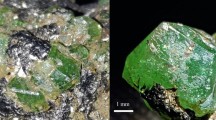Abstract
Natural specimens of green gemological euclase (chemical formula BeAlSiO4(OH)) from Brazil were investigated by electron paramagnetic resonance (EPR) and optical absorption. In addition to iron-related EPR spectra, analyzed recently in blue and colorless euclase, chromium and vanadium-related EPR spectra were also detected in green euclase. Their role as color causing centers is discussed. The results indicate that Cr3+ ions substitute for Al3+ ions in the euclase structure. The EPR rotation patterns of Cr3+ with electron spin S = 3/2 were analyzed with monoclinic spin Hamiltonian leading to the parameters of g xx , g yy and g zz equal to 2.018, 2.001 and 1.956 and electronic fine structure parameters of D = −8.27 GHz and E = 1.11 GHz, respectively, with high asymmetry ratio E/D = 0.13. For the vanadium-related EPR spectra the situation is different. It is concluded that vanadium is incorporated as the vanadyl radical VO2+ with electron spin S = 1/2 with nearly axial spin Hamiltonian parameters gzz = 1.9447, g xx = 1.9740 g yy = 1.9669 and axial hyperfine interactions due to the nuclear spin I = 7/2 of the 51V isotope leading to A zz = 502 MHz, A xx = 150 MHz and A yy = 163 MHz. The green color of euclase is caused by two strong broad absorption bands centered at 17,185 and 24,345 cm−1 which are attributed to the 4A2g → 4T2g, 4T1g transitions of Cr3+, respectively. Vanadyl radicals may introduce some absorption bands centered in the near infrared with tail extending into the visible spectral range.




Similar content being viewed by others
References
Abragam A, Bleaney B (1986) Electron paramagnetic resonance of transition ions. Dover, New York
Barry WR, Troup GJ (1969) EPR of Cr3+ in alexandrite. Phys Stat Sol B 35:861–864
Eades RG (1955) An investigation of the nuclear resonance absorption spectrum of Al27 in a single crystal of euclase. Can J Phys 33:286–297
Eliseev AP, Yurkin AM, Samoilova EG (1988) Cr3+ energy levels in alexandrite. Phys Stat Sol A 88:K169–K173
García-Lastra JM, Aramburu JA, Barriuso MT, Moreno M (2006) Optical properties of Cr3+-doped oxides: different behavior of two centers in alexandrite. Phys Rev B 74:115118–1–5
Geusic JE, Peter M, Schulz-du Bois EO (1959) Paramagnetic resonance spectrum of Cr+++ in Emerald. Bell Syst Tech J 38:291–296
Graziani G, Guidi G (1980) Euclase from Santa do Encoberto, Minas Gerais, Brazil. Am Miner 65:183–187
Guedes KJ, Krambrock K, Pinheiro MVB, Menezes Filho LAD (2006) Natural iron-containing blue and colorless euclase studied by electron paramagnetic resonance. Phys Chem Miner 33:553–557
Hazen RM, Au AY, Finger LW (1986) High-pressure crystal chemistry of beryl (Be3Al2Si6O18) and euclase (BeAlSiO4OH). Am Miner 71:977–984
Hutton DR (1971) Paramagnetic resonance of VO2+, Cr3+ and Fe3+ in zoisite. J Phys C Solid State Phys 4:1251–1257
Hutton DR, Darmann FA, Troup GJ (1991) Electron spin resonance of V4+(VO2+) in Beryl. Aust J Phys 44:429–434
Koziarska B, Godlewski M, Suchoki A, Czaja M, Mazurak Z (1994) Optical properties of zoisite. Phys Rev B 50:12297–12300
Laurance N, Lambe J (1963) Quadrupole interactions of vanadium and manganese in corundum. Phys Rev 132:1029–1036
Marshall JLe, Hutton DR, Troup GJ, Thyer JRW (1971) A paramagnetic resonance study of Cr3+ and Fe3+ in sillimanite. Phys Stat Sol A 5:769–773
McGavin DG (1987) Symmetry constrains on EPR spin-Hamiltonian parameters. J Magn Reson 74:10–55
Mrose ME, Appleman DE (1962) The crystal structures and crystal chemistry of väyrynenite (Mn,Fe)Be(PO4)(OH), and euclase AlBe(SiO4)(OH). Zeitschrift fuer Kristallographie 117:16–36
Nassau K (1983) The physics and chemistry of color. Wiley, New York
Acknowledgments
We acknowledge financial support from the Brazilian agencies FINEP, FAPEMIG, CNPq and CAPES. We are grateful to W.T. Soares of the Physics Department of the Universidade Federal de Minas Gerais for the electron microprobe analysis and Luiz Menezes, Belo Horizonte, for providing the samples.
Author information
Authors and Affiliations
Corresponding author
Rights and permissions
About this article
Cite this article
Krambrock, K., Guedes, K.J. & Pinheiro, M.V.B. Chromium and vanadium impurities in natural green euclase and their relation to the color. Phys Chem Minerals 35, 409–415 (2008). https://doi.org/10.1007/s00269-008-0235-5
Received:
Accepted:
Published:
Issue Date:
DOI: https://doi.org/10.1007/s00269-008-0235-5




